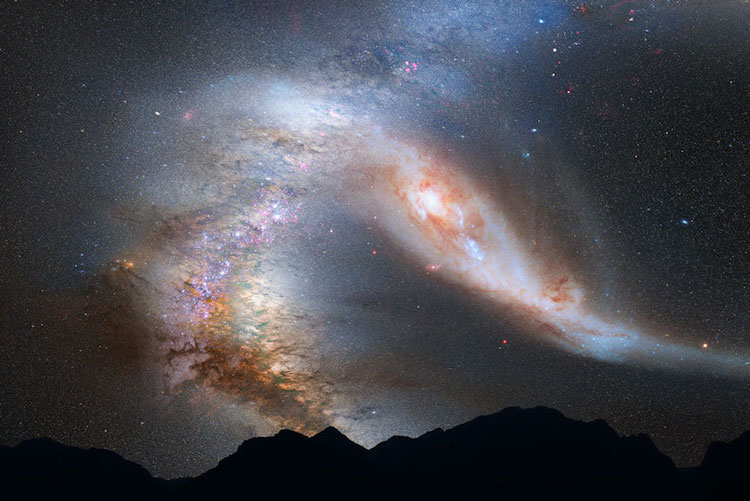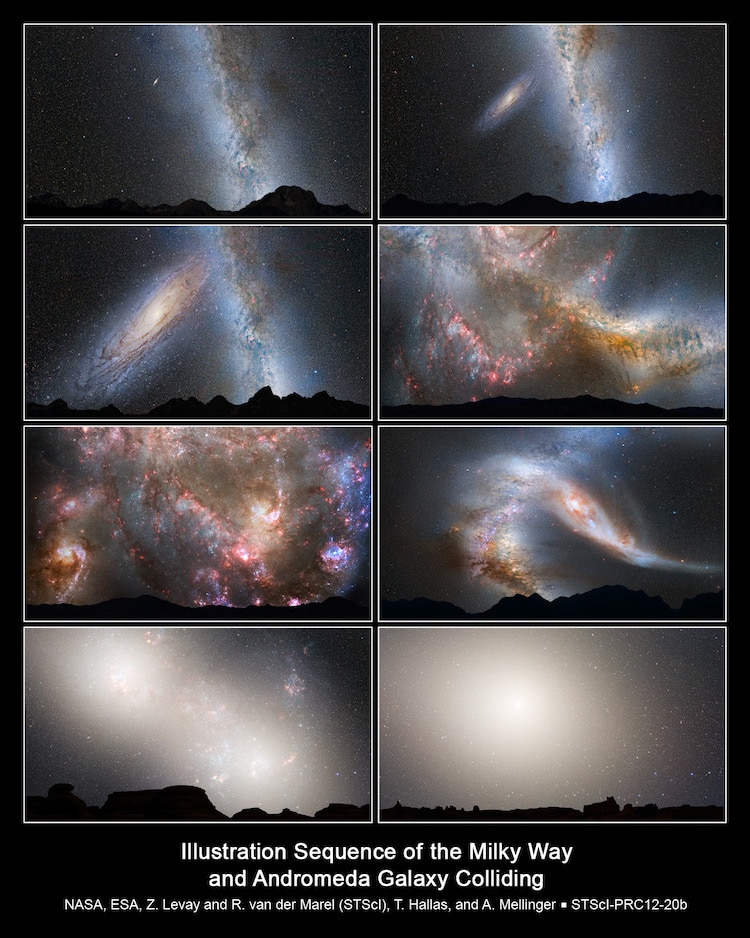
Illustration: NASA, ESA, Z. Levay and R. van der Marel (STScI), and A. Mellinger
When we gaze out into the night sky, all may appear calm, but looks can be deceiving. Though we may not feel it, our galaxy—the Milky Way—is hurtling through the universe at an astonishing 1.3 million miles per hour. And, it’s on a crash course with its neighbor—the Andromeda Galaxy. While these spiral galaxies are 2.5 million light years apart, that won’t always be the case.
The Andromeda Galaxy, which is far larger than the Milky Way, is hurtling toward us at 68 miles per second. And while that might seem fast, given the distance between these galaxies it will still take 4 billion years for them to collide. Eventually, in about 6 billion years, they will transform from two separate spiral galaxies into one giant spherical galaxy. This new galaxy, which is sometimes called Milkomeda or Milkdromeda, will also see the merger of the supermassive black holes that reside at the centers of the Milky Way and Andromeda.
Though the thought of such a large collision sounds scary, scientists point out that due to the distance between stars, it is unlikely that individual stars will collide. And our solar system? That should be safe too. Researchers have estimated that it will likely be swept to the outskirts of the new galaxy, though this is also a small chance that it could be ejected completely from Milkomeda. Either way, it’s unlikely that humans will be around to see this spectacular light show, as at this point the Sun will have grown so hot that it will have terminated life on Earth.
View this post on Instagram
What’s incredible about the Andromeda-Milky Way Collision is that we’ve known about it for hundreds of years. In the early 1900s, astronomer Vesto Slipher predicted that the Andromeda Galaxy was headed directly toward the Milky Way. Since that time, many astronomers have created simulations to see if these galaxies would meet head-on or simply skirt past each other. In 2012, data from the Hubble Telescope confirmed that there would definitely be a collision.
It’s important to remember that these types of collisions are quite normal and expected. In fact, the Milky Way was already involved in a large collision about 10 billion years ago and larger galaxies often absorb smaller galaxies in their orbit. While we may not be around to see the formation of Milkomeda, it’s incredible to look at the simulations and know that we’re using science to predict the future.
In 4 billion years, the Milky Way and Andromeda galaxies will collide.
At that point, they will form one galaxy nicknamed Milkomeda or Milkdromeda.

Photo: NASA
Watch this simulation to see the spectacular light show that awaits.
Related Articles:
Hubble Snaps Incredible Photo of a Faraway Galaxy
Massive 2.2-Gigapixel Photo of the Milky Way Captured in One Night
NASA Says About 300 Million Habitable Planets Could Exist in the Milky Way
Spectacular Time-Lapse Footage Taken by World’s First Spacecraft To “Touch the Sun”
